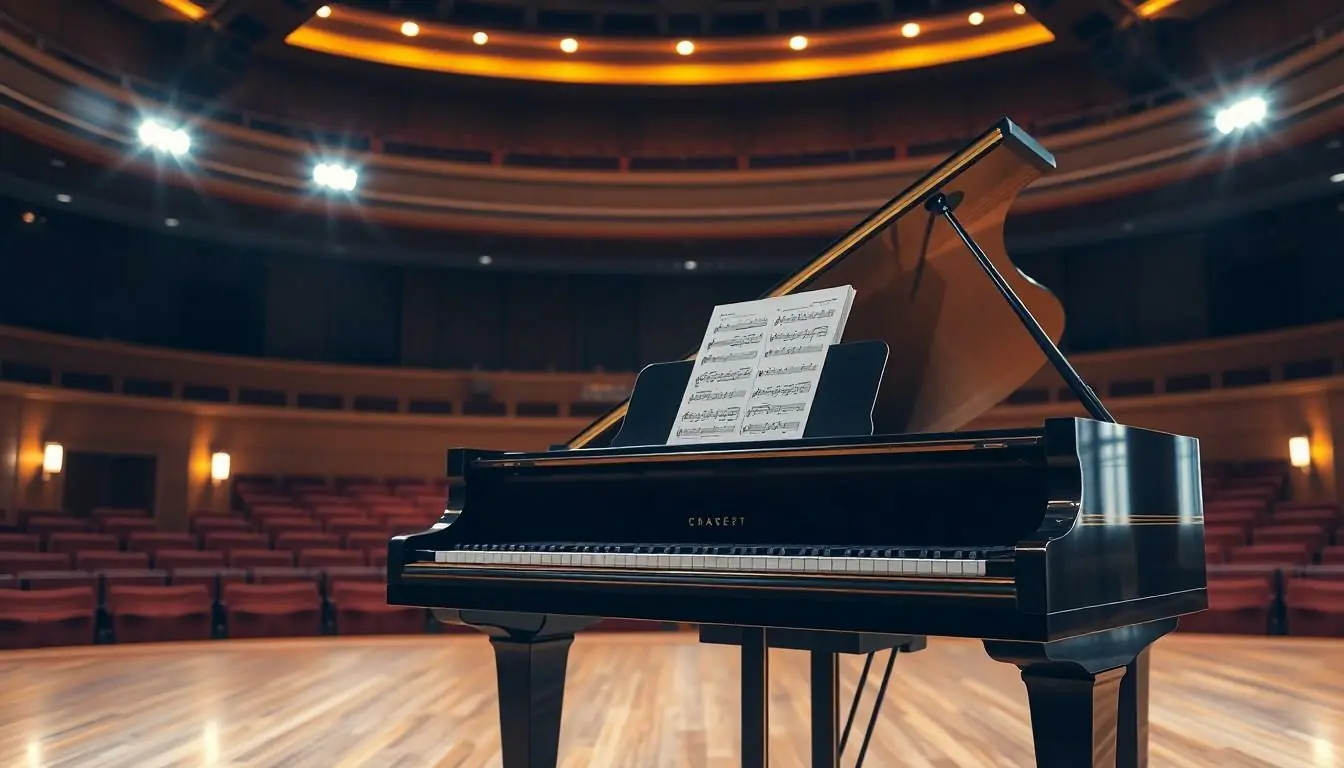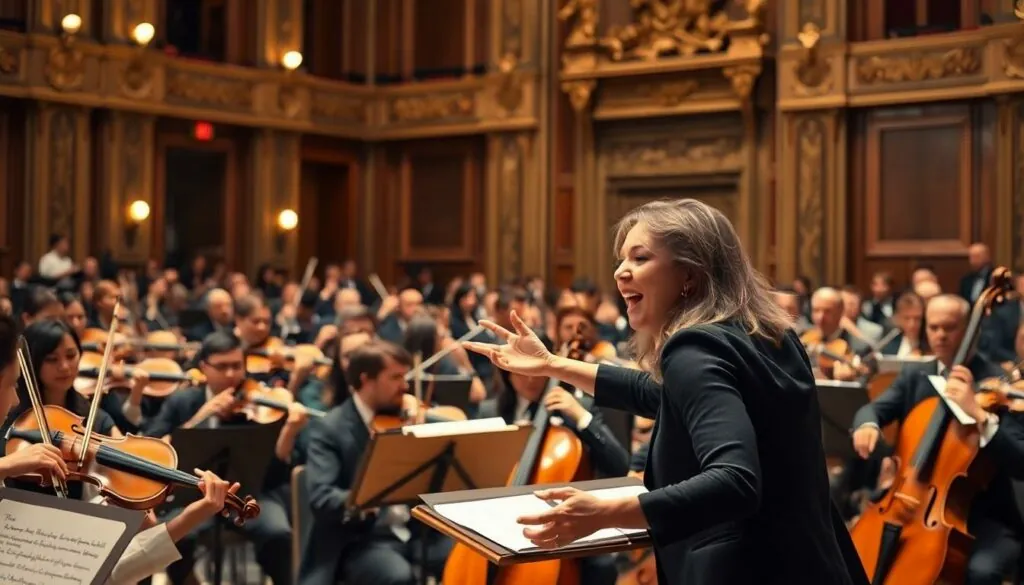Table of Contents
ToggleClassical music often seems like an exclusive club, reserved for those in tuxedos sipping champagne. But don’t let that fool you—this genre is brimming with fascinating characteristics that can charm even the most skeptical ears. From soaring melodies to intricate harmonies, classical music is like a buffet of sound, offering something for everyone.
Imagine a world where emotions dance through notes, where a single violin can evoke joy or sorrow. It’s not just for the stuffy concert hall; it’s the soundtrack to life’s most dramatic moments. Understanding classical music’s unique traits can unlock a deeper appreciation for its beauty and complexity. So grab your metaphorical baton and prepare to dive into the captivating world of classical music characteristics—who knew learning could be this harmonious?
Overview of Classical Music Characteristics
Classical music features distinct characteristics that set it apart from other genres. It exhibits structured forms, such as sonatas, symphonies, and concertos, providing a framework for composition. Melodies often soar, filled with emotion and complexity, capturing the listener’s attention.
Harmonic intricacy plays a crucial role in this genre. Chord progressions contribute to the depth of the music, creating a rich tapestry of sound. Dynamics in classical music vary widely, ranging from soft whispers to grand crescendos, enhancing emotional expression.
Instrumentation showcases a variety of instruments, each contributing its unique timbre. Strings, woodwinds, brass, and percussion work in harmony, creating a unified sound while maintaining individual character. Notable orchestrations highlight the skill of composers in blending these instruments effectively.
Rhythm in classical music often diverges from popular music trends. It can feature complex rhythmic patterns, providing a sense of movement and flow. Various time signatures, like 4/4 or 3/4, facilitate different feels and styles within compositions.
Lastly, performance practices define the execution of classical music. Musicians adhere to interpretive traditions while injecting personal expression into their playing. This combination fosters a deep connection with the music, allowing audiences to experience the nuances of each piece.
Key Elements of Classical Music

Classical music features distinct elements that contribute to its rich character. Understanding these key components reveals the depth of its artistic expression.
Melody and Harmony
Melody serves as the central thread in classical compositions. It often features memorable themes that evolve throughout the piece. Harmonies enrich these melodies, utilizing intricate chord structures. Variations in harmony create emotional landscapes that engage listeners. For example, composers like Beethoven and Mozart employed complex harmonic progressions to enhance their musical narratives. The interaction between melody and harmony fosters a dynamic experience, inviting audiences into the music’s emotional depths.
Rhythm and Tempo
Rhythm plays a critical role in defining the character of classical music. It encompasses various patterns that drive the music forward. Composers often incorporate syncopation and changing meters to create interest. Tempo provides the pace for a piece, influencing its overall feel. Notably, some compositions shift tempos to heighten drama or excitement. For instance, a lively allegro contrasts sharply with a serene adagio, showcasing the versatility of rhythm and tempo within classical works. This interplay adds layers of complexity that captivate listeners.
Instrumentation in Classical Music
Instrumentation plays a vital role in shaping the sound of classical music. Compositions typically feature orchestras, combining strings, woodwinds, brass, and percussion for a rich auditory experience.
Orchestral Compositions
Orchestral compositions utilize various sections for distinct sound qualities. Strings, including violins, violas, cellos, and double basses, form the foundation, providing warmth and depth. Woodwinds, such as flutes, oboes, clarinets, and bassoons, add color and nuance to the texture. Brass instruments, including trumpets, trombones, and tubas, contribute power and brilliance. Percussion instruments like timpani, snare drums, and cymbals create rhythm and emphasis, enhancing dynamic contrasts. These elements together craft complex orchestral works, allowing composers to explore a wide palette of emotions.
Solo Instruments
Solo instruments highlight individual artistry within classical music. The piano stands out for its versatility, allowing for expressive melodies and rich harmonies. Violin solos often showcase technical prowess and emotional depth, captivating listeners with intricate passages. The cello, known for its warm tones, offers a unique voice, often playing both melody and harmony. Instruments like the flute or trumpet can deliver striking, lyrical lines that resonate with audiences. Each solo performance invites personal interpretation, fostering a profound connection between the artist and the listener.
Styles and Periods in Classical Music
Classical music encompasses several distinct styles and periods, each marked by unique characteristics and innovations.
Baroque Era
The Baroque Era spanned from approximately 1600 to 1750. Composers like Johann Sebastian Bach and George Frideric Handel defined this period with their intricate musical structures. Ornamentation dominates this era, with embellishments adding flair to melodies. Instruments such as the violin and harpsichord were prominent, enhancing the rich textures. Counterpoint gained significant attention, showcasing the ability to weave multiple independent lines together harmoniously. String ensembles and orchestras began to emerge, allowing for more dynamic expressions and dramatic contrasts.
Classical Era
This era, lasting from about 1750 to 1820, emphasized clarity and balance in musical composition. Renowned composers like Wolfgang Amadeus Mozart and Joseph Haydn revolutionized the symphony and string quartet forms. The sonata-allegro structure became a fundamental aspect of this period, providing a clear framework for compositions. Simplicity in melody stood central, focusing on memorable, singable lines. Dynamic contrasts, such as sudden changes from loud to soft, created engaging musical dialogues. This time also saw the development of the piano, which replaced the harpsichord as the primary keyboard instrument.
Romantic Era
The Romantic Era followed, spanning from roughly 1820 to 1900, characterized by emotional expression and individualism. Composers like Johannes Brahms and Pyotr Ilyich Tchaikovsky explored profound themes through expansive orchestration and innovative harmonies. Emotionally charged melodies captured the complexities of human experience. Programmatic music became popular, telling stories or conveying imagery through sound. The use of rich chromaticism and lush harmonies expanded musical palettes. This era also celebrated virtuoso soloists, with compositions showcasing technical prowess and deep personal expression.
Influence of Classical Music
Classical music significantly shapes culture and modern musical practices. It often serves as a foundation for various genres and art forms, inspiring countless artists.
Cultural Impact
Classical music profoundly influences a range of cultures worldwide. It enters films, enhancing emotional depth with orchestral scores. In contemporary dance, classical pieces guide movement with their rhythm and dynamics. Educational programs utilize classical music to develop cognitive skills in children, promoting concentration and creativity. Institutions often integrate it into curricula, fostering an appreciation from a young age. Many international competitions celebrate classical music, highlighting its importance in nurturing future talent. Events like the annual Beethoven Festival celebrate this legacy, attracting audiences who appreciate its historical significance.
Modern Adaptations
Modern adaptations of classical music breathe new life into traditional compositions. Artists remix classic pieces, blending genres like hip-hop and electronic music to create fresh sounds. Film scores often draw on classical themes, connecting audiences with their emotional resonance. Additionally, contemporary interpretations of classical works reach broader audiences through streaming platforms and social media. Many orchestras now experiment with interactive concerts, inviting audience participation. Such innovations attract younger demographics, proving classical music’s relevance in today’s entertainment landscape. Remix cultures also redefine how listeners engage with classical music, making it accessible and appealing to a new generation.
Classical music stands as a testament to human creativity and emotional expression. Its intricate structures and rich harmonies invite listeners to explore a world of depth and nuance. Each era contributes unique characteristics that enhance its allure and relevance.
The genre’s ability to adapt and inspire across various platforms ensures its place in modern culture. As audiences continue to discover classical music’s beauty they unlock a profound connection to its timeless artistry. Engaging with this genre not only enriches personal experiences but also fosters a greater appreciation for the diverse tapestry of musical expression.





